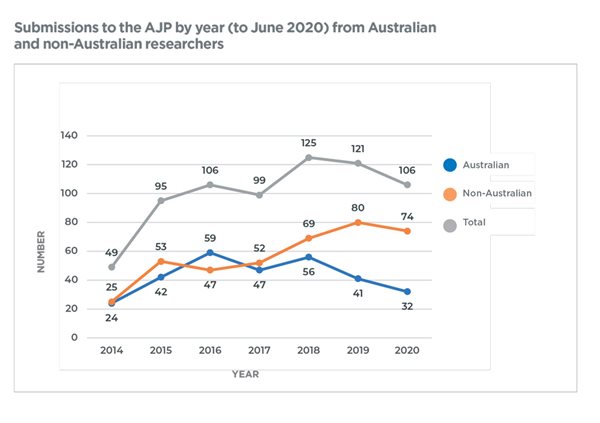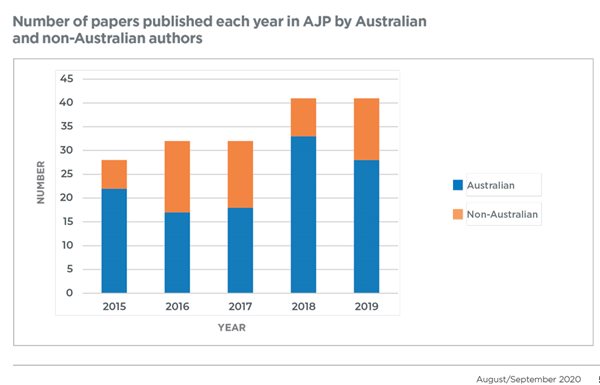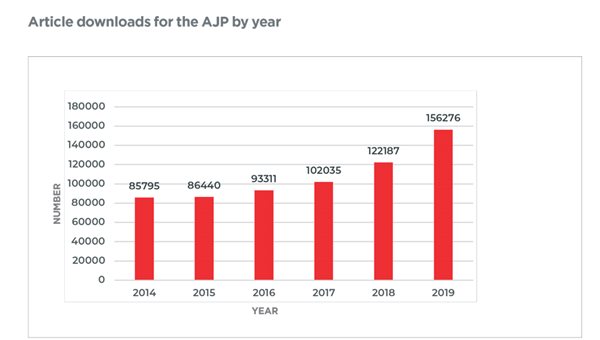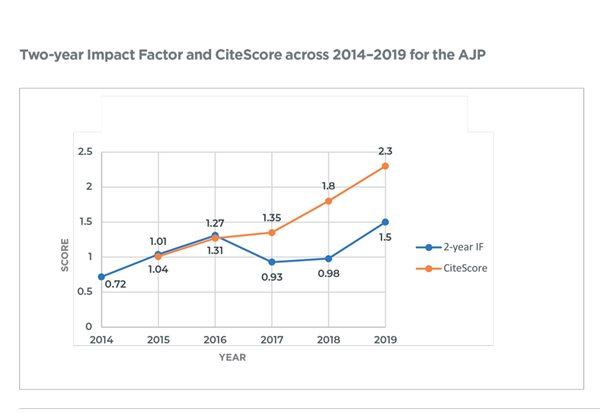Reflections on my tenure as editor-in-chief of the Australian Journal of Psychology
I took over as editor-in-chief for the Australian Journal of Psychology (AJP) in October 2014. Why become editor-in-chief of the AJP? Because to me it is the most important academic role in Australian psychology and I consider it a great honour. My predecessor was Graham Tyson and I am very grateful for his help which allowed me to hit the ground running.
What does an editor-in-chief do?
An editor-in-chief has final responsibility for the publication. The aim is to ensure a high-quality publication and always to strive to improve the standing of the journal so that researchers will seek to publish in it. As part of my role, I read every submission and determine whether it is important enough to be sent to an associate editor. The associate editors are the subject-matter experts; they recruit reviewers and take a paper through the process of review, revision, acceptance or rejection. As editor-in-chief, I have the final say, but most of the time I agree with an associate editor’s decision.
Journey highlights
My first goal was to increase the number of submissions to the AJP, while also increasing its international footprint. The graph below shows the performance of the AJP on these metrics over my time as editor-in-chief.
The first thing to note is that the number of submissions has grown steadily across the past six years. Indeed, submissions in 2018 were up 255 per cent on 2014, and in 2019, they were up 247 per cent. The numbers for 2020 represent those up to the end of June. More papers have already been submitted than in all of 2014, 2015 and 2017. Further, more papers have been submitted by non-Australian researchers in 2020 than for Australian researchers for each year I have been editor-in-chief.
Growth in international submissions
The number of submissions from Australian researchers has remained relatively constant over the years. Submissions moved up from 24 in 2014 and have averaged at about 50 submissions per year in subsequent years. In contrast, the number of submissions from non-Australian researchers has increased over the years, reaching 80 submissions in 2019. It is this increase in submissions from non-Australian researchers that accounts for the increase in submissions overall.
At the same time, the country of origin of submissions has become much broader. There were submissions from 14 different countries in 2014. This had risen to 28 in 2018 and 2019. Indeed, over my years as editor-in-chief, submissions have been received from researchers in 61 different countries. Importantly, this variety is also being reflected in papers published. The overall acceptance rate over these years is 30.3 per cent.
Australian researchers still have an advantage in terms of the likelihood of their article being accepted at 51.2 per cent. However, a country such as China now enjoys an acceptance rate of 19.0 per cent, almost the same as papers submitted by researchers from the United States of America at 20.0 per cent. The 106 papers already submitted in 2020 encompass 26 different countries.
Further cementing the ‘internationalisation’ of the journal, over the period 2015–2019, some 278 reviewers out of a total of 549 (51.3%) were from outside Australia. Thanks to all of them and the 17 associate editors who worked with them!


Considerable local representation
An analysis of the British Journal of Psychology showed that significant numbers of British academics published in ‘their’ journal. I looked at the sources of Australian papers for the years 2014–2019. Published papers emanated from some 37 Australian institutions (out of 41 members of the Heads of Department and Schools of Psychology Association), including all of those universities classified as ‘Group of Eight’. Clearly, Australian academics also support their journal.
Fortunately, the increase in the number of submissions has not led to a bottleneck in publications. The APS and Wiley kindly approved a change to the ceiling on page numbers and so the increase in submissions has been accompanied by an increase in papers published by year.
Expanding the focus
In addition to research articles, I wanted to encourage researchers to publish reviews in the AJP. Reviews are attractive to the general readership. After a slow start, with no reviews published in 2015, some 13 reviews have now been published. Likewise, authors and readers find Special Issues attractive. We have now published three Special Issues, with a fourth in progress.
Journals are often sold as a ‘package’. Hence it can be difficult to determine who is reading what. One way of overcoming this problem is to look at the number of articles downloaded each year. Again, downloads have increased significantly across the years as illustrated opposite. In 2019, 68 per cent of downloads were from countries other than Australia, again in keeping with the internationalisation of the journal.
Measuring success
Journals are subject to a number of metrics, which are often used to define their quality. The following shows the performance of the AJP on two such measures from 2014 to 2019. The two-year Impact Factor is often regarded as the ‘gold standard’ of journal metrics. The two-year Impact Factor has risen across the years to be 1.486 in 2019. Likewise, a new measure of impact, the CiteScore, has increased from 1.01 on its introduction in 2015 to reach 2.3 in 2019.

More recently, a new set of metrics, called Altmetrics, which includes mentions in the media, including social media, promises to broaden measures of impact in the future. Other changes to the publishing landscape, such as moving to Open Access, promise to make the next few years an exciting time to be a journal editor. I hope that the new editor of the AJP enjoys their tenure as much as I have enjoyed mine.
